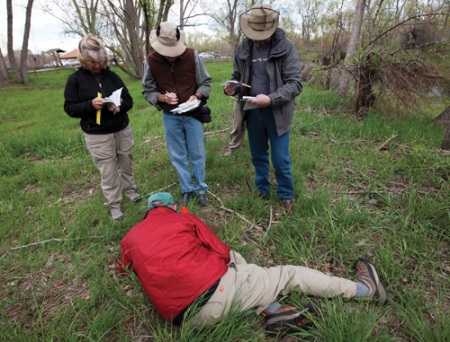Nose to the Ground
As a kid, Marty Colón spent his days studying tracks in the tacky sands of Lake Michigan’s shore. He would find a track, identify the animal that made it, then follow its path up and down the beach.
That’s a pretty great childhood.
Essentially, Marty is still following the tracks of his childhood. Now, however, he’s tracking mammals big and small and teaching others the rewards of observing the signs, scats, and tracks beneath their feet.
There are stories imprinted in the soil. While you’re sleeping, when you’re not around, when you’re at work in the city, animals are roaming the woods, riverbanks, and alpine tundra. If you never see these animals, it doesn’t mean they don’t exist—or that you can’t unravel the mystery of their behavior.
Tracking offers an extension to what we see. With a bit of patience, an investigative method, and dirt on your knees, you can figure out what animal it was that went down the trail before you.
Marty has been teaching tracking skills for 30 years. He’s honed his method to three simple steps. Follow them (and take a tracking class or two) and you will not only be able to follow the animal’s tracks, you’ll be able to see an entirely new world of behavior that wasn’t apparent before.
1) Collecting Track Level Evidence
As the name implies, track level evidence is on the ground—not in a book, and not in your brain. When you come across a track, be careful not to guess, thinking you are familiar with the print. Be careful not to exclude certain species based on your presumed familiarity with its habitat and range. When I took a class with Marty, we found a black bear track in Prospect Park. Yup, in the middle of Wheat Ridge.
There are four pieces of evidence that you will want to look for—and write down in a notebook. First, count the number of digits. In Colorado, that can be four, five, or two (technically, the ungulates—things like deer and elk—have a hoof made of two clouts).
After you’ve determined the number of digits, you’ll want to decide whether they are long and slender like fingers, or short and stubby like your big toe. If you can see any claws, note whether they’ve made a fine point near the tip of the digit (indicative of claws that are curved at a 90-degre angle and good for climbing) or are a bit thicker (like a dog’s claws, which are your general purpose claw—not built exclusively for climbing or digging). If you see the indication of a long, thick claw that extends well beyond the end of the digit, you’ve probably found the track of a digger—things like skunks, badgers, and wolverines.
Finally, make note (in fact, make a sketch) of the shape of the interdigital pad, the surface that sits behind the digits—it can look heart-shaped, bean-shaped, and sometimes like the heel of a human.
2) Determining Family
If you know the number of digits in a track, you can start to hone in on the family of your animal. Four digits? It’s very likely to be from the dog, cat, or rabbit family. Or it could be from the rodent family, whose animals have four front digits and five in the rear.
Five digits? It will have to be from the raccoon, opossum, shrew, bear, or weasel family (things like wolverine, sea otter, badger, skunk, marten, and ferret). Again, rodents have five digits on their rear feet so you could have yourself a rodent track.
Two digits? That’s a bit easier; you’ve found a track from the deer family: bison, moose, elk, bighorn sheep, mountain goat, caribou, mule and white-tailed deer, or pronghorn.
If you know the structure and function of those digits, you can eliminate even further. Are they long, finger-like digits that would be good for grasping and climbing? Think of raccoons and squirrels. Are they short and blunt, general purpose toes? Think dogs, cats, and bears.
Next, the shape of the interdigital pad tells you even more. Based on it’s shape, you can further refine your search.
3) Determining Species
Now you’re ready to take the final step and unravel the mystery. Here, you can use a series of gross filters to eliminate species within each possible family. First, look at size. Using a tracking field guide, you can determine if the track is near in size to the average track for a particular species. Too big or too small and you can eliminate that animal from your list of suspects. Be sure not to measure claws—or overshoot your evidence. That is, don’t eliminate an animal unless you’re absolutely sure. In the end, you may not have enough evidence to narrow it down to only one species.
Marty’s guide of choice? Falcon Guide’s Scats and Tracks series. There’s one specific to the Rocky Mountains that’s small enough to carry each time you head into the outdoors.
Power in Numbers
Certainly, this brief overview isn’t enough to turn you into an expert tracker, or a citizen scientist. But we all possess what it takes to start as a citizen naturalist. And perhaps this lesson will inspire you to learn more. With a bit of training and a sound method, the skill of tracking (and scat and sign identification) can make every landscape come alive in a new way.
Still, you may be thinking that these simple observations are just that: simple. But, over time and in large quantities, the information that citizens collect can tell us a lot about the changes taking place in a landscape and its viability as suitable habitat. No, they won’t replace raw data, scientific inquiry, or thorough research, but they can wholeheartedly supplement it. And they give us a role in preserving and protecting Colorado’s wild places and wild things. That’s quite a powerful feeling.
Read the first part of The Power to Protect: Citizen Conservation.



